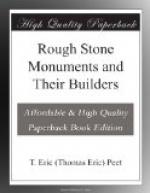[Illustration: FIG. 3. (a)—Barrow
at Stoney Littleton, Somersetshire.
(b)—Barrow
at Rodmarton, Gloucestershire.
(c)—Chambers
of barrow at Uley, Gloucestershire.
(After
Thurnam, Archaeologia, XLII.)]
Turning first to the Wiltshire and Gloucestershire group of barrows we find that they are usually from 120 to 200 feet in length and from 30 to 60 in breadth. In some cases there is a wall of dry stone-masonry around the foot of the mound and outside this a ditch. The megalithic chambers within the mound are of three types. In the first there is a central gallery entering the mound at its thicker end and leading to a chamber or series of chambers (Fig. 3, a and c). Where this gallery enters the mound there is a cusp-shaped break in the outline of the mound as marked by the dry walling, and the entrance is closed by a stone block. The chambers are formed of large slabs set up on edge. Occasionally there are spaces between successive slabs, and these are filled up with dry masonry. The roof is made either by laying large slabs across the tops of the sides or by corbelling with smaller slabs as at Stoney Littleton.
In the second type of chambered barrow there is no central corridor, but chambers are built in opposite pairs on the outside edge of the mound and opening outwards (Fig. 3, b). The two best known examples of this are the tumuli of Avening and of Rodmarton.
In the third type of barrow there is no chamber connected with the outside, but its place is taken by several dolmens—so small as to be mere cists—within the mound.
The burials in these barrows seem to have been without exception inhumations. The body was placed in the crouched position, either sitting up or reclining. In an untouched chamber at Rodmarton were found as many as thirteen bodies, and in the eastern chamber at Charlton’s Abbott there were twelve. With the bodies lay pottery, vases, and implements of flint and bone.
CHAPTER III
MEGALITHIC MONUMENTS IN SCOTLAND AND IRELAND
The stone circles of Scotland have been divided into three types—the Western Scottish, consisting of a rather irregular ring or pair of concentric rings; the Inverness type, in which a chamber entered by a straight passage is covered by a round tumulus with a retaining wall of stone, the whole being surrounded by a regular stone circle; and the Aberdeen type, which is similar to the last, but has a ‘recumbent’ stone between two of the uprights of its outer circle.




